
The cutlassfishes are about 45 species of predatory fish in the family Trichiuridae of the order Scombriformes found in seas throughout the world. Fish of this family are long, slender, and generally steely blue or silver in colour, giving rise to their name. They have reduced or absent pelvic and caudal fins, giving them an eel-like appearance, and large fang-like teeth.

Sweepers are small, tropical marine perciform fish of the family Pempheridae. Found in the western Atlantic Ocean and Indo-Pacific region, the family contains about 26 species in two genera. One species is the target of subsistence fisheries in Japan, where the fish is much enjoyed for its taste. Sweepers are occasionally kept in marine aquaria.

Sebastes is a genus of marine ray-finned fish belonging to the subfamily Sebastinae part of the family Scorpaenidae, most of which have the common name of rockfish. A few are called ocean perch, sea perch or redfish instead. They are found in the Atlantic and Pacific Oceans.

The Priacanthidae, the bigeyes, are a family of 18 species of marine ray-finned fishes. "Catalufa" is an alternate common name for some members of the Priacanthidae. The etymology of the scientific name refers to the family's very rough, spined scales. The common name of "bigeye" refers to the member species' unusually large eyes, suited to their carnivorous and nocturnal lifestyles. Priacanthidae are typically colored bright red, but some have patterns in silver, dusky brown, or black. Most species reach a maximum total length of about 30 cm (12 in), although in a few species lengths of over 50 cm (20 in) are known.

The bigeye sand tiger is an extremely rare species of mackerel shark in the family Odontaspididae, with a possible worldwide distribution. A large, bulky species reaching at least 3.6 m (12 ft) in length, the bigeye sand tiger has a long bulbous snout, large orange eyes without nictitating membranes, and a capacious mouth with the narrow teeth prominently exposed. It can be distinguished from the similar smalltooth sand tiger by its teeth, which have only one lateral cusplet on each side, and by its uniformly dark brown color.

Argyrosomus is a genus of marine ray-finned fishes belonging to the family Sciaenidae, the drums. The fish in this genus are large and are commonly targeted as game fish.

Heteropriacanthus, the glasseyes or glass bigeyes, are a genus of the bigeye family found in all tropical seas around the world. It occasionally makes its way into the aquarium trade. It grows to a size of 50.7 cm (20.0 in) in total length.

The popeye catalufa, also known as the bigeye soldierfish, is a species of marine ray-finned fish in the family Priacanthidae, the bigeyes. This fish has an overall dusky orange to red colour with white markings. The dorsal fin appears feathery while rest of fins have black margins. It occurs in the eastern Pacific, where it is found from Oregon to Chile. It occasionally makes its way into the aquarium trade. It grows to a size of 34 centimetres (13 in) in length. This species is nocturnal and shy, preferring deeper waters off islands. It has been recorded associating with squirrelfishes and cardinalfishes but the popeye catalufa goes as deep as 76 metres (249 ft), deeper than its associated species. This species has been recorded from rocky habitats at depths of less than 5 metres (16 ft) to over 100 metres (330 ft). It is a carnivorous species and, when kept in captivity, is known to feed on worms, crustaceans and brittle stars.

Guentherus is a genus of jellynose fishes, belonging to the Ateleopodidae family, with two recognized species:
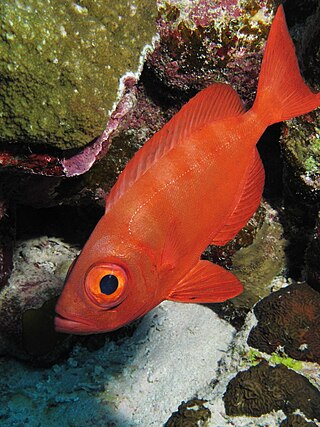
Priacanthus hamrur, the lunar-tailed bigeye, goggle eye, or moontail bullseye, is a species of marine fishes belonging to the family Priacanthidae.

Pristigenys is a genus of marine ray-finned fish in the family Priacanthidae. It contains five extant species and one extinct species, P. substriata, which is known from fossils found in the Eocene of Monte Bolca, Italy.

Pristigenys niphonia, the Japanese bigeye, is a species of marine ray-finned fish in the family Priacanthidae. It occurs in the western Pacific Ocean.

Pentaceros is a genus of marine ray-finned fish, armorheads from the family Pentacerotidae. They are native to the Pacific, Indian, and eastern Atlantic Oceans. Pentaceros is the only genus in the monotypic subfamily Pentacerotinae.
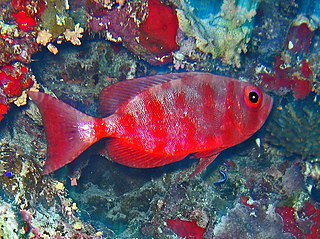
Priacanthus is a genus of marine ray-finned fishes belonging to the family Priacanthidae, the bigeyes. As of 2012 there are 12 species in the genus.
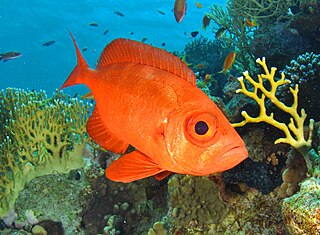
Priacanthus blochii, the paeony bulleye, is a species of marine ray finned fish, a bigeye in the family Priacanthidae. Other common names for this species include Bloch's bigeye, blotched bigeye, glass-eyebigeye, shortfin bigeye, silver big-eye and goggle eye.
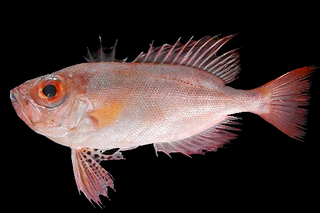
Priacanthus tayenus, commonly known as purple-spotted bigeye, is a species of marine ray finned fish, a bigeye in the family Priacanthidae. It is native to the Indian and Pacific Oceans.
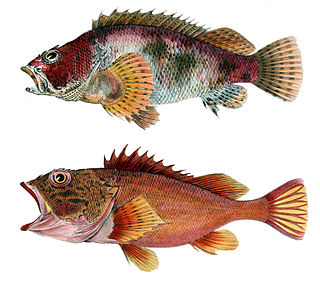
Sebastiscus marmoratus, the sea ruffe, false kelpfish or dusky stingfish, is a species of marine ray-finned fish belonging to the subfamily Sebastinae, the rockfishes, part of the family Scorpaenidae. It is found in the Western Pacific from southern Japan to the Philippines. It has also been sighted twice in Australia.

Priacanthus arenatus, the toro or Atlantic bigeye, is a species of marine ray finned fish, a bigeye in the family Priacanthidae. Some anglers refer to this fish as "toro snapper", but it is not a snapper, and only distantly related to the fish of the snapper family. It is found across much of the Atlantic ocean.
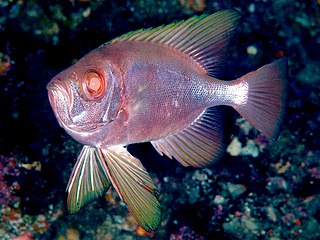
Cookeolus is a genus of marine ray-finned fishes from the family Priacanthidae, the bigeyes. It contains one extant species and one extinct species.
Inegocia japonica, the Japanese flathead, rusty flathead or smooth flathead, is a species of marine ray-finned fish belonging to the family Platycephalidae, the flatheads. It is found in the Indo-West Pacific region.


















